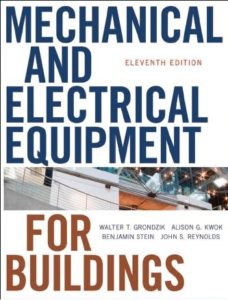Mechanical and Electrical Equipment for Buildings 11th Edition
Mechanical and Electrical Equipment for Buildings 11th Edition
Mechanical and Electrical Equipment for Buildings 11th Edition written primarily for the North American building design community and has always emphasized examples from this region. Yet other areas of the world, some with similar traditions and fuel sources, have worthy examples of new strategies for building design utilizing on‐site energy and energy conservation. Thus, buildings from Europe and Asia appear in this 12th edition, along with many North American examples. Listings of such buildings (and associated researchers and designers) have been included in the index of this edition. Design standards presented in this book are generally reflective of practice in the United States; this is a result of our experiences, but also reflects a desire not to confuse readers by listing the many, many variations in design standards that exist across the globe.
You can also Read Mechanical and Electrical Equipment for Buildings 12th Edition
Mechanical and Electrical Equipment for Buildings 11th Edition
- THE BUILDING DESIGN CONTEXT
![Mechanical and Electrical Equipment for Buildings 11th Edition]()
- DESIGN Fundamentals
- PASSIVE ENVIRONMENTAL SYSTEMS
- ACTIVE ENVIRONMENTAL SYSTEMS
- ACOUSTICS
- FIRE PROTECTION
- ELECTRICITY
- SIGNAL SYSTEMS
- TRANSPORTATION
- A:Metrication, SI Units, and Conversions
- B:Climatic Conditions for the United States, Canada, and Mexico
- C:Solar and Daylighting Design Data
- D:Solar Geometry
- E:Thermal Properties of Materials and Assemblies
- F:Ventilation and Infiltration
- G:Heating and Cooling Design Guidelines and Information
- H:Standards/Guidelines for Energy- and Resource-Efficient Building Design
- I:Annual Solar Performance
- J:Economic Analysis
- K:Sound Transmission Data
- L:Design Analysis Software
digital control systems has encouraged this trend. Further encouragement comes from multipurpose buildings whose schedules of occupancy are fragmented and from corporations with varying work schedules that result in partial occupancy on week-ends. Another factor in this move to decentralization is worker satisfaction; there is increasingly solid evidence that productivity increases with a sense of individual control of one’s work environment. Residences are commonly being used as office work environments. Expanding communications networks have made this possible. As residential designs thus become more complex (with office‐quality lighting, zones for heating/cooling, sophisticated communications, noise control), our nonresidential work environments become more attractive and individual.
Download
Mechanical and Electrical Equipment for Buildings 11th Edition
2nd Link Here


Comments are closed.